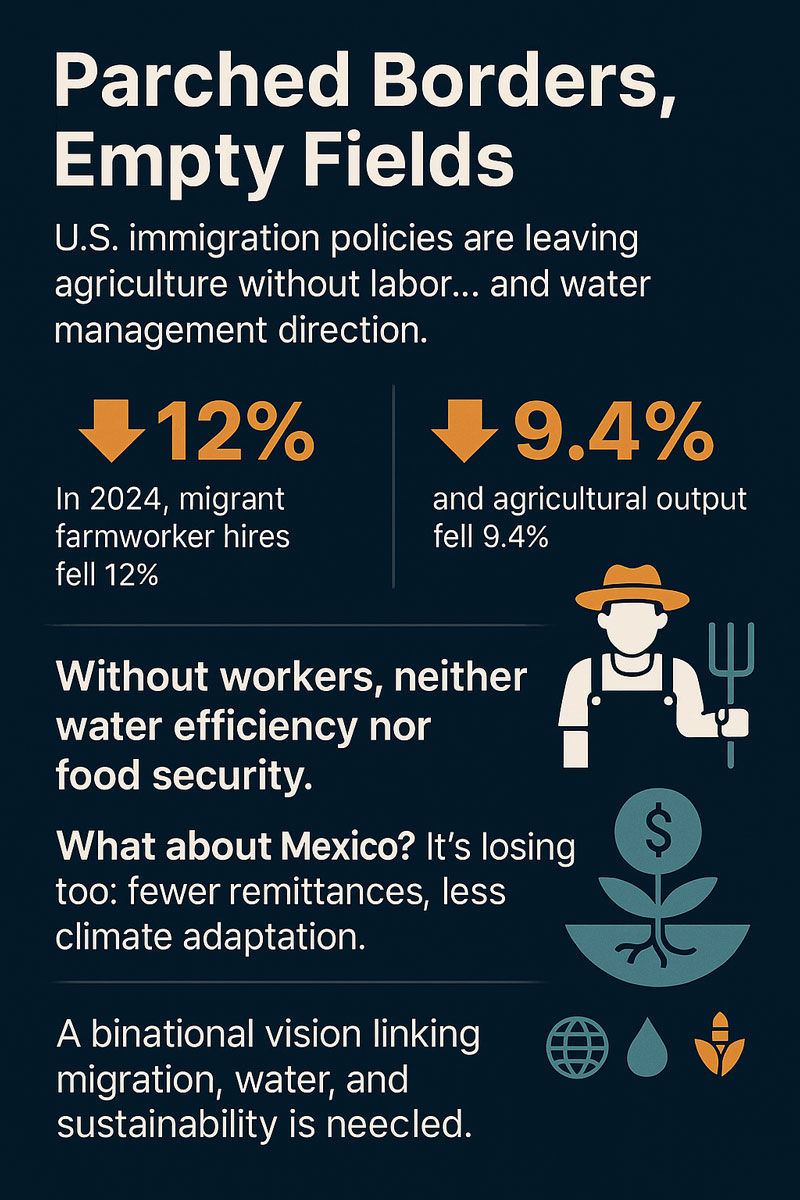Dry borders, empty fields, the migration crisis threatening water and food in North America
- Editorial

- Jul 31
- 3 min read

In the agricultural regions of California, Arizona, Texas, and Florida—where over 60% of the fruits and vegetables consumed in the United States are grown—reliance on migrant workers, mostly of Mexican origin, is absolute. However, throughout 2024, the tightening of U.S. immigration policies triggered a domino effect that now threatens not only food security but also the efficient management of water in agricultural regions highly vulnerable to climate change.
The passage of more restrictive state laws—such as SB1718 in Florida and immigration status verification mandates in Texas—significantly reduced the availability of farm labor. According to the Migration Policy Institute, formal hiring of migrant farmworkers in the U.S. dropped by 12% in 2024, a decline felt most acutely in the southwestern agricultural states. This drop coincided with a 9.4% decrease in national fruit and vegetable production, directly affecting water planning, as the demand for irrigation becomes more erratic and inefficient when harvest cycles are disrupted.
Agriculture is the largest consumer of water in the United States, accounting for approximately 42% of total freshwater usage, according to the U.S. Geological Survey. Migrant labor not only plants and harvests crops, but also plays a key role in irrigation management, soil conservation, and reducing water waste. Their prolonged absence weakens the implementation of technologies such as drip irrigation, automated monitoring systems, and the shift from high-consumption crops to more resilient alternatives. Researchers at the University of California, Davis, warn that in areas like the San Joaquin Valley, the shortage of skilled workers forced producers to leave more than 155,000 hectares uncultivated in 2024—an inefficient use of existing water infrastructure.
At the same time, investment in agricultural technology focused on water efficiency increased by 17% in 2024, driven by state and private funding. However, many of these innovations—like smart moisture sensors or artificial intelligence for irrigation forecasting—depend on field implementation by trained workers, most of whom are migrants. Without a coherent immigration policy that integrates temporary work visas with training and retention programs, this technology risks being underutilized or misapplied, as warned by the Center for Strategic & International Studies in its April 2025 report.

Moreover, the pressure on water systems is not just caused by labor shortages but also by extreme climate events such as megadroughts, which have increased in frequency and intensity. The lack of skilled personnel prevents farmers from responding in a timely and adaptive manner to these emergencies, reducing the sector’s resilience. In this context, the combination of restricted labor migration, underused technology, and climate crisis creates a perfect storm for North American agriculture.
The outlook is equally complex from Mexico’s perspective. Many of the migrants who work in the U.S. agricultural sector come from regions in El Bajío and southern Mexico, where drought and aquifer overuse have made farming increasingly unviable. In this context, migration is not only about better opportunities—it’s also a climate adaptation strategy. Through remittances—which reached $63.2 billion in 2024—many Mexican communities fund rainwater harvesting systems, communal irrigation infrastructure, or agroecological transitions. If the U.S. shuts the door to this labor force, it also indirectly undermines the water resilience of hundreds of Mexican municipalities.
Looking ahead to 2025, the main challenge will be to establish bilateral mechanisms that integrate immigration policy, water management, and food security into a unified ecosystem. The current fragmented approach—treating migration as a security issue, water as an environmental problem, and agriculture as an economic matter—has proven ineffective in the face of 21st-century challenges. States like California and New Mexico are already discussing pilot programs for “green visas” that link temporary legal status for migrants with training in sustainable agricultural and water practices.

Mexico, for its part, must strengthen its diplomatic channels not only to defend the rights of its citizens, but also to promote a shared narrative in which migrant farmworkers are recognized as sustainability agents on both sides of the border. Coordination between the Ministry of Foreign Affairs and State Water Commissions must go beyond consular services and aim for productive alliances involving universities, tech centers, and private agricultural actors.
In short, ignoring the interdependence between migration, water, and agriculture is a costly gamble for both nations. If current inertia continues, the U.S. could face a food crisis accompanied by rising prices and declining agricultural competitiveness. Mexico, meanwhile, will face limited capacity for climate adaptation in rural communities. Only a binational vision—driven by political will and technical cooperation—can turn this challenge into a shared opportunity.
Written by: Editorial




Comments